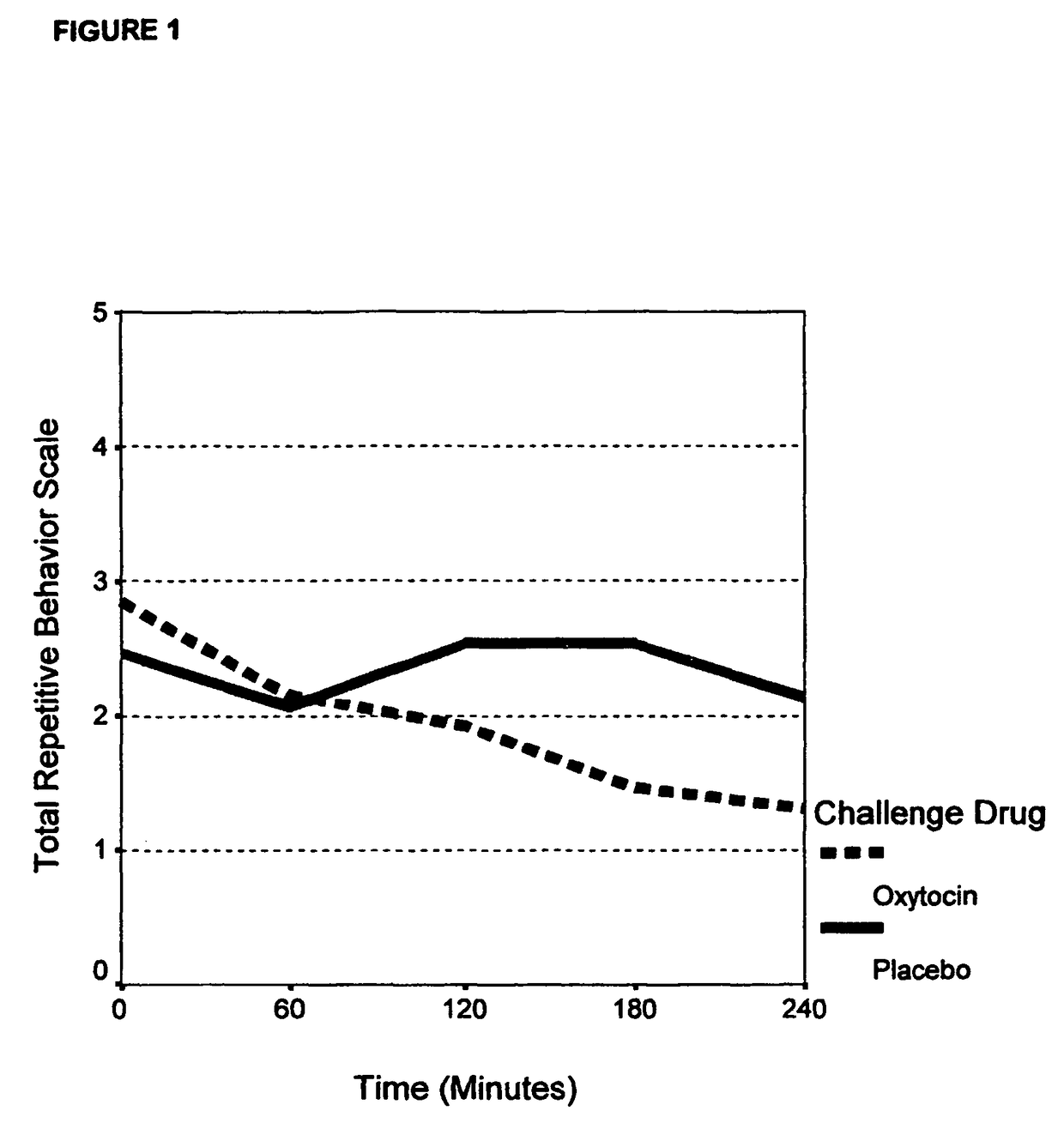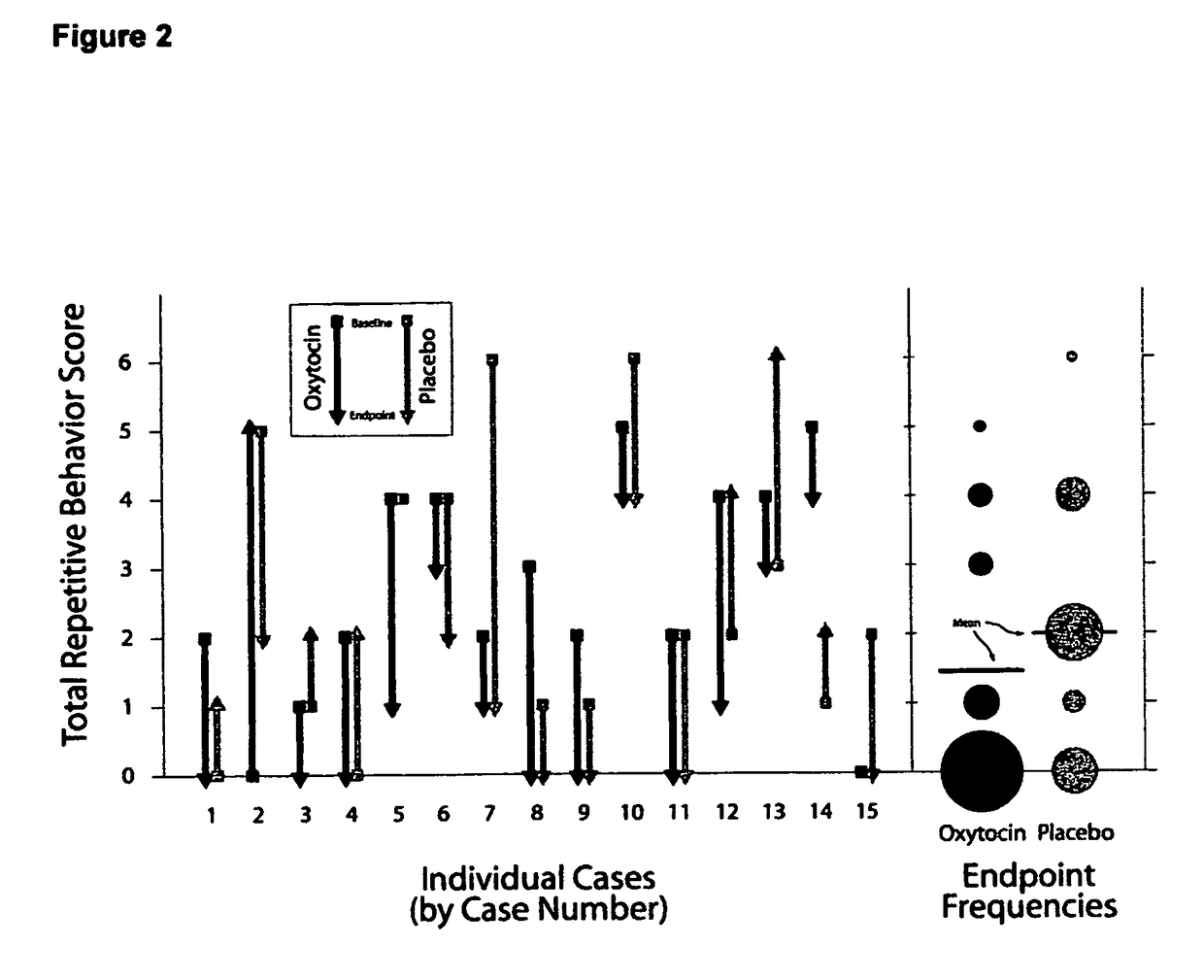Treatment of autism and similar disorders
a technology for applied in the field of autism and similar disorders, can solve the problems of social deficit, lack of eye contact, and diminished ability to carry on conversation, and achieve the effects of traits associated, reducing the severity of behaviors associated, and increasing the level of oxytocin
- Summary
- Abstract
- Description
- Claims
- Application Information
AI Technical Summary
Benefits of technology
Problems solved by technology
Method used
Image
Examples
example 1
Treatment of Adults with Autistic and Asperger's Disorders with Oxytocin
Experimental Design
[0069]To evaluate the role of oxytocin in treating autism spectrum disorders, fifteen adult patients (mean age=32.9 years, range=19.4-55.6) (14 male, 1 female) diagnosed with autism (N=6) or Asperger's disorder (N=9) received oxytocin and placebo challenges during visits separated by 2-3 weeks to the General Clinical Research Center of the Department of Psychiatry, Seaver Autism Research Center at the Mount Sinai School of Medicine (New York, N.Y.). All patents were carefully evaluated and diagnosed according to both DSM-IV criteria and the Autism Diagnostic Interview-Revised (Lord C, Rutter M, LeCouteur A (1994): Autism Diagnostic Interview-Revised: a revised version of a diagnostic scale for caregivers of individuals with possible pervasive developmental disorders. Journal of Autism and Developmental Disorders 24:659-685.), on which the patients with autism scored within the autistic range a...
example 2
Treatment of Individuals with Asperger's Disorders with Oxytocin and A Psychopharmacologic Agent
[0082]Benefits may be reaped by co-administering oxytocin and a psychopharmacologic agent to patients diagnosed with Asperger's disorder. Oxytocin and the psychopharmacologic agent may be administered in the same infusion mixture. The initial vial of Pitocin® (10 u / mL) and / or valium (10 u / mL) can be combined aseptically with a 1.0 L bag of normal saline and administered at a rate of 10 mL / hr. The infusion can be initiated at a low rate to minimize potential side effects, and the rate gradually titrated up. Specifically, the infusion rate can be titrated every 15 minutes by 25 mL in the first hour, 50 mL in the second hour, 100 mL in the third hour, and then held constant at the maximum rate of 700 mL / hr during the fourth hour. The combined solution, rotated in an infusion bottle to insure thorough mixing, can be added to the system by a constant infusion pump to accurately control the rat...
example 3
Treatment of Individuals with Attention Deficiency Disorder (ADD) with Oxytocin
[0084]Individuals with attention deficiency disorder (ADD) can be treated with Oxytocin and or Oxytocin analogs either alone or in combination with another agent as described in Examples 1 and 2.
PUM
| Property | Measurement | Unit |
|---|---|---|
| delay time | aaaaa | aaaaa |
| delay time | aaaaa | aaaaa |
| delay time | aaaaa | aaaaa |
Abstract
Description
Claims
Application Information
 Login to View More
Login to View More - R&D
- Intellectual Property
- Life Sciences
- Materials
- Tech Scout
- Unparalleled Data Quality
- Higher Quality Content
- 60% Fewer Hallucinations
Browse by: Latest US Patents, China's latest patents, Technical Efficacy Thesaurus, Application Domain, Technology Topic, Popular Technical Reports.
© 2025 PatSnap. All rights reserved.Legal|Privacy policy|Modern Slavery Act Transparency Statement|Sitemap|About US| Contact US: help@patsnap.com



